INSIGHTS: Tips and Tricks for Organizing Your Galley
One of the main challenges that liveaboard cruiser Sarah Powell discovered when she stepped aboard her 30ft boat for the first time was not only what to cook, but also how to cook in a galley space that was less than one square meter in size. Since then, she has gathered a wealth of essential equipment and storage tips to make cooking and provisioning simple and easy, which she shares in this INSIGHTS article for Noonsite.
Published 9 months ago
Cooking is an important part of my life and happens to be my happy place. When I first stepped foot aboard Vega, our Halmatic 30 (a 30ft boat with a galley less than one square meter or 10 square feet) it took me a while to figure out what to cook and how to cook in such a small space. In fact the very first night I looked bewildered at the stove and said “We are ordering pizza tonight!”
I lost quite a lot of my life in the first few months in the top-loading fridge and searching for items became a frustrating task.
My first few supermarket shops were a big fail. I filled my trolley like we still lived in a house. I realised quickly that if I wanted to continue enjoying cooking I had to look at provisioning on a boat in a completely different way.
That was back in 2017, and since then I have gathered a heap of information, tips and tricks and share my nuggets of wisdom here with you in this Galley Guide.
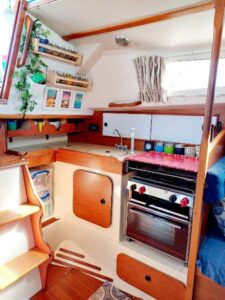

Whether your galley is as small as Vegas’ or as big as a superyacht, this article offers practical tips and essential steps to get you thinking about how you can set up your floating kitchen for smooth sailing during passage and enjoyable on-board meals at anchor and in the marina.
Whilst the elements are more or less the same in your kitchen on land (a cooker, a sink, worktops, cupboards etc.) there is a distinct challenge that lies ahead. Boats are not rectangles and standard is not a word often used to describe storage space.
Organizing Your Galley
Maximize Space:
Utilize every inch of your galley efficiently. The best way to do this is to install racks, hooks, and shelves to make use of vertical space.
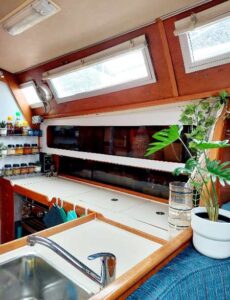

Opt for collapsible or nesting cookware:
You can find a wide variety of nesting pans on the market from reputable brands. They generally come with a removable handle and take up little space. I now use nesting pans and have found them a great way to not only save on storage, but also versatile to use as the handle is removable the shallow pans can double up as baking tins. I also have a collapsable colander and collapsable storage containers which are great for easy storage when not in use.
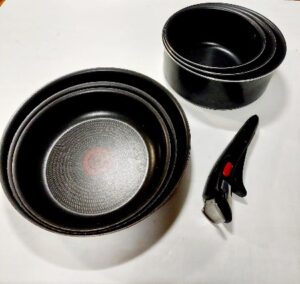

Create Zones:
Designate specific areas for different tasks such as food prep, cooking, and storage. This helps frequently used items to be within easy reach and means you can store less frequently used items in accessible but out-of-the-way places.
Think about how you cook and what items you use most. For example, onboard Kahu, almost every day I will use olive oil, garlic and onion, I keep these items within easy reach.
I also keep the tins I use most in an easy-access locker just under the oven. It is a rather odd shape (like many lockers on a monohull) and was originally where the diesel heating pipes were run from. We have since ditched the diesel heating as we optimistically endeavour to chase the sun and warm climates!
Secure Items:
When on passage I roll out a nonslip mat that covers the whole worktop, that way no matter what I place on it I can be sure that it should not slide off easily.
Whilst we all know how important it is to ensure that all items in your galley are securely stowed to prevent them from becoming projectiles in difficult passages, most of us have been faced with the daunting task of clearing up the aftermath of forgotten-to-stowaway items in rough seas at some stage or another. I suggest keeping all surfaces clear and doing a quick audit before weighing anchor or leaving the dock. Keep non-slip mats handy and even think about adding latches or bungees to keep things in place.
Keep It Clean:
Hot weather, humid climates and temperamental boat fridges can be the perfect breeding ground for unwanted bacteria. I suggest having anti/bacterial cleaning spray on hand to ensure clean surfaces and galley storage areas. If you want to make a homemade all-purpose spray, I make up a solution of equal parts vinegar and water and add some lemon juice. It’s a bit more watery than the usual kitchen spray, but it smells fresh, degreases smoothly, keeps the bacteria at bay, and reduces packaging and carbon footprint!
Essential Galley Equipment
So now we have our galley organised and clean what equipment do we really need? Here I have listed some of the items I believe are essential to making cooking in a galley as enjoyable as possible.
Kettle: a great way to safely boil water for that all-important cup of tea or coffee.
Good quality cookware: Opt for durable, non-corrosive cookware that can withstand the rigours of marine life. Stainless steel and aluminium are popular choices for boat cookware due to their durability and resistance to rust and with a non-stick coating this makes for better-cooked foods and easy cleaning. I mentioned above the advantages of nesting pots and pans for easy storage.
I also use almost daily a pressure cooker. It is my time-saving friend, and allows us to get the best nutrition value from most of the things we cook in it, from dhals to rice and soups to stews, it also makes quick work of cooking dried beans and legumes and I can have the most delicious almond milk and cinnamon rice pudding ready in 5 minutes. Look out for my forthcoming article on revolutionizing cooking on a boat – how a pressure cooker can change your galley game.
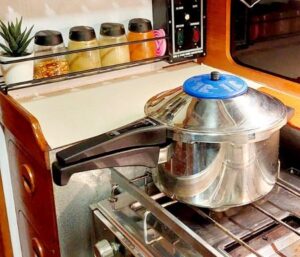

Cutlery and Utensils: Stock your galley with essential items such as:
- Sharp knives – Trust me blunt ones are more dangerous!
- Spatula – I could literally write a book on how good the simple silicone spatula is for the galley (in fact I have written an in-depth article on smallvegankitchen.com if you are interested). It is great for scraping all leftovers from plates, pots and pans meaning less water is needed to wash up and less food scraps to clog up the delicate boat drains. It is also very handy when it comes to baking, as you can use it to spread and fold ingredients.
- Tongs – took me a while to get the hang of using tongs for cooking but they are great for turning food whilst frying in a pan, handy to mix sauce with pasta and most definitely handy when it comes to the all-important BBQ.
Airtight Containers: Store dry goods such as flour, sugar, and cereal in airtight containers to prevent them from becoming stale or attracting pests. A good tip is to choose containers that are stackable and space-saving to maximize storage space in your galley.
Food Storage Tip: Add a bay leaf to pasta, grains and flour to prevent weevils.
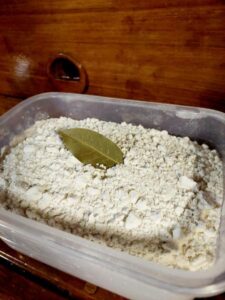

Ziplock reusable bags: These are a must-have item onboard. Make sure you get good quality ones as otherwise they can turn into single-use fast. They come in different sizes which makes them one of the best and most versatile ways to store ingredients and food onboard. I use the smaller ones for spices (make sure you label them!) and even pre-blend spice mixes that I use for Indian, Mexican and Moroccan recipes.
I use the medium-sized ones for pre-prepared dried mixtures to simplify cooking nutritious food on passage (plant-based pancake mixture, breakfast oats with seeds and cinnamon, Moroccan flavoured couscous using a teaspoon of Moroccan premixed seasoning with 2 cups of dried couscous). The larger ones are handy for storing dried goods such as pasta, rice, legumes and beans.
Permanent marker: In my galley drawer, I have a permanent marker at easy reach to quickly label tins, Ziplock bags and packaging.
Sharp Scissors: Can make cutting safer and easier on passage than using a knife or even your teeth! Great for herbs, spring onions, packed items, etc.
Vacuum Sealer: Vacuum-sealing foods can help extend their shelf life by removing air and preventing spoilage. You can vacuum-seal individual portions of batch-cooked meals which is great for preparing for passage The shelf-life of other perishable ingredients such as fruits, vegetables, meat and fish can also prolonged if you vacuum-seal them before storing them in your refrigerator or cooler.
To Wrap Up
In the ebb and flow of life at sea, an organized galley is your compass. Equipped with these valuable pointers and handy hints, you’re well on your way to enhancing the whole experience of preparing meals in a relatively small space with minimum equipment.
Feel free to connect with fellow cruisers and explore their galley setups. Each boat is a unique universe and I’m continually amazed by the ingenuity and resourcefulness of my fellow sailors.
Engaging with others not only sparks inspiration but also encourages me to reimagine my own approach. Remember: where there’s motivation, success is bound to follow!
Fair winds and bon appétit!
Sarah Powell
…………………………………
See more insightful articles at Noonsite’s INSIGHTS
…………………………………
About the Author:
Sarah Powell is a full-time live-aboard cruiser currently based in Lanzarote for the forthcoming year. She passionately believes in provisioning and preparing nourishing, nutrient-rich, mood-enhancing foods to support the active and emotional adventure of living at sea and crossing an ocean.


All of the recipes and knowledge that she has learnt over the years, come from the experience gained in the galley of her previous Halmatic 30 and current Sigma 41.
Through seminars and workshops she shares, with cruisers and sailors, how it is possible to prepare delicious nutrient-dense food in the smallest of kitchens, with minimal equipment from wherever you are sailing around the world. You can read more about Sarah at:
- Website: www.smallvegankitchen.com
- Linkedin: https://www.linkedin.com/in/sarahpowellfowler
- Instagram: www.instagram.com/smallvegankitchen.com
- Facebook: www.facebook.com/smallvegankitchen
…………………………………
The opinions expressed in this article are the author’s own and do not reflect the view of Noonsite.com or World Cruising.
…………………………………
Find out all news, reports, links and comments posted on Noonsite, plus cruising information from around the world, by subscribing to our FREE monthly newsletter. Go to https://www.noonsite.com/newsletter/.
Related to the following Cruising Resources: Equipment, Insights, Liveaboard Tips, Planning and Preparation



